IT Infrastructure is a complicated system that consists of a variety of physical infrastructure components, such as firewalls, servers, switches, and load balancers, as well as virtual infrastructure components, like Xen, VMWare, Nutanix, Hyper-V, and applications. As the complexity of IT infrastructure increases at a never-before-seen pace, IT admins are engaged in a constant battle to keep their networks efficient and up to date. This is where you can benefit from a dedicated strategy for managing your IT infrastructure, with the right IT infrastructure management software.
Key takeaways
- Having a firm grasp on the challenges and roadblocks in IT infrastructure management can help you devise an efficient and viable strategy for exhaustive IT infrastructure management.
- Knowing about the various components of IT infrastructure management and other intricate details about it can help guide you on how to manage your IT infrastructure, not just efficiently but proactively as well.
- Having a single tool to oversee and handle the entire IT infrastructure, including networks, servers, storage, applications, bandwidth, configurations, IP addresses, and switch ports, can help you simplify management and save resources.
To manage your IT infrastructure better, it is important that we discuss,
- Challenges in managing your IT infrastructure without an ITIM tool
- Components of IT infrastructure management
- OpManager Plus: Your IT infrastructure management & observability software
- Advantages of OpManager Plus as a Network ITIM tool
Challenges in managing your IT infrastructure without an ITIM tool

- Monitoring availability and health challenges
- Performance, process, and service-level challenges
- Configuration management challenges
- Optimizing bandwidth challenges
- Compliance implementation challenges
- Infrastructure security challenges
- IP address management challenges
- Integration challenges
- Storage management challenges
Monitoring availability and health challenges
IT infrastructure management (ITIM) begins with ensuring the availability and health of all the devices and interfaces connected to your network. To avoid any unexpected issues, you need to ensure business-critical devices are monitored 24x7.
Performance, process, and service-level challenges
Monitoring performance metrics in IT infrastructure demands an organized approach. It's important to manage vendor heterogeneity to determine factors to be monitored for performance, and performance metrics such as CPU and memory utilization, packet drop, temperature, fan speed etc. have to be monitored for efficiency. Priority can be given to certain devices and their parameters after considering factors like the criticality of the monitoring parameter, as well as the criticality of the device.
IT infrastructure is only as efficient as its ability to deliver business solutions. Apart from device availability, service and process availability also play a big role; if an IT infrastructure management service or process stops running, it could directly or indirectly impact the business solution intended to be delivered, resulting in a loss for the business. For this reason, in addition to device performance, monitoring the IT infrastructure management process and services running on your devices must be given equal importance.
Configuration management challenges
Configuration changes in your infrastructure should follow only role-based approval. Every time a configuration change is pushed to devices, there's a chance it could go wrong and plunge the device into downtime. There are various factors contributing to this, such as misconfiguration, poorly deployed configuration parameter changes, conflicting configuration values, etc.
Human misconfiguration errors, especially during critical processes like firmware upgrades, can bring the entire network to a standstill. Not only do you need to ensure that a backup disaster recovery policy is in place as a fail-safe option, but you should also track and maintain a detailed report on the configuration changes implemented on the infrastructure devices.
Optimizing bandwidth challenges
Every network has a limited bandwidth, and it's your job to ensure sufficient bandwidth is allocated for all business-critical applications. You should also ensure individual devices do not exceed their bandwidth allocation by analyzing individual users' bandwidth consumption; this will ultimately help you understand your network traffic patterns better, enabling you to form an effective bandwidth usage strategy.
Compliance implementation challenges
As the size of your organization grows, so do the number of devices in the network, which is directly proportional to the efforts required to ensure the infrastructure stays compliant with various industry specific policies (SOX, HIPAA, PCI DSS, SANS, etc.). It's crucial to ensure all devices stay compliant by following the required protocols, and deploy necessary measures if any policy is violated.
Infrastructure security challenges
When it comes to the security of your IT infrastructure, you must ensure your firewall is compliant with the latest standards, perform log analysis to identify security threats, monitor internet usage by supervising virtual private network (VPN) and proxy users, and more. Only by establishing a sound security strategy will your firewall infrastructure function efficiently.
IP address management challenges
When adding new devices to IT infrastructure, you have to ensure that no two devices share the same IP address. Keeping tabs on the IP addresses in use enables you to quickly allocate unused IP addresses to the new devices and prevent IP conflict. In addition to that, you must also restrict devices with rogue IP addresses from accessing the network, as they pose a risk to security.
Integration challenges
IT infrastructure management solutions cannot be limited to simply monitoring devices and receiving alerts on time. The faults identified via alerts should be addressed in a timely manner, and for that, integrations play a vital role. Integrations are used to extend the functionalities and monitoring prowess of an IT infrastructure management tool. Choosing a tool that integrates with the appropriate third-party tools, such as ITSM tools, communication tools, and alarm management tools, will greatly increase the efficiency of overall network operation.
Storage management challenges
The amount of data storage organizations require is rapidly growing, and with that comes a compelling need to monitor that storage. Storage management tasks include identifying growth trends, monitoring capacity utilization, and making sure your organization never runs out of storage space.
Components of IT infrastructure management
IT infrastructure management can be divided into the following six components,
- Classify physical and virtual devices
- Determination of critical KPI
- Visualization
- Monitoring and alerting
- Notifications
- Fault management
Classify physical and virtual devices: Physical and virtual devices should be classified and monitored constantly which helps effortlessly identify any lag in performance, errors, and malfunctions. This helps reach an optimal performance of both physical devices like servers, routers, etc., and virtual devices like Vmware, Nutanix, and Hyper-V.
Determination of critical KPI: Each device falls under different categories when it comes to the level of criticality and so their metrics. To manage IT infrastructure efficiently, it is vital to identify critical metrics of each device and provide attention to each one of them accordingly.
Visualization: Downright visibility across the IT infrastructure helps technicians keep track of performance and other critical metrics meticulously. This helps out in taking proactive measures in order to eliminate device failures or downtime.
Monitoring and alerting: Constant monitoring and sending alerts to technicians proactively when there is a network fault, go hand in hand in the process of securing the devices from malfunction. This highly contributes to maintaining network stability.
Notifications: Sending precise notifications to the right technician team through the right channel plays an important part in building a network that is resistant to downtime. As it tremendously helps the team to fix the issues immediately.
Fault management: L1 and L2 basic network operation faults should be automated in order to resolve them rapidly which potentially enhances the performance of devices and highly reduce MTTR.
OpManager Plus: Your IT infrastructure management & observability software
Your organization needs to be equipped with a single tool that can perform all the above operations for effective IT infrastructure monitoring and business service delivery. Manage your IT infrastructure with OpManager Plus, an effcient ITIM and a data center infrastructure management (DCIM) software. It is a collection of powerful features at its core that can address all your ITIM woes.
IT infrastructure performance management
Infrastructure failure and poor performance are two major nightmares that concern every IT admin. OpManager Plus boasts an advanced IT infrastructure health, availability, performance monitoring feature pool with support for over 8,000 devices and more than 200 performance metrics. Monitoring of health and performance is not restricted to devices; OpManager Plus, a holistic ITIM tool equips you with capabilities powerful enough to monitor even the interfaces, processes, and services associated with a device, thereby ensuring optimum health, effective performance, and maximum efficiency of the hardware in the IT infrastructure.
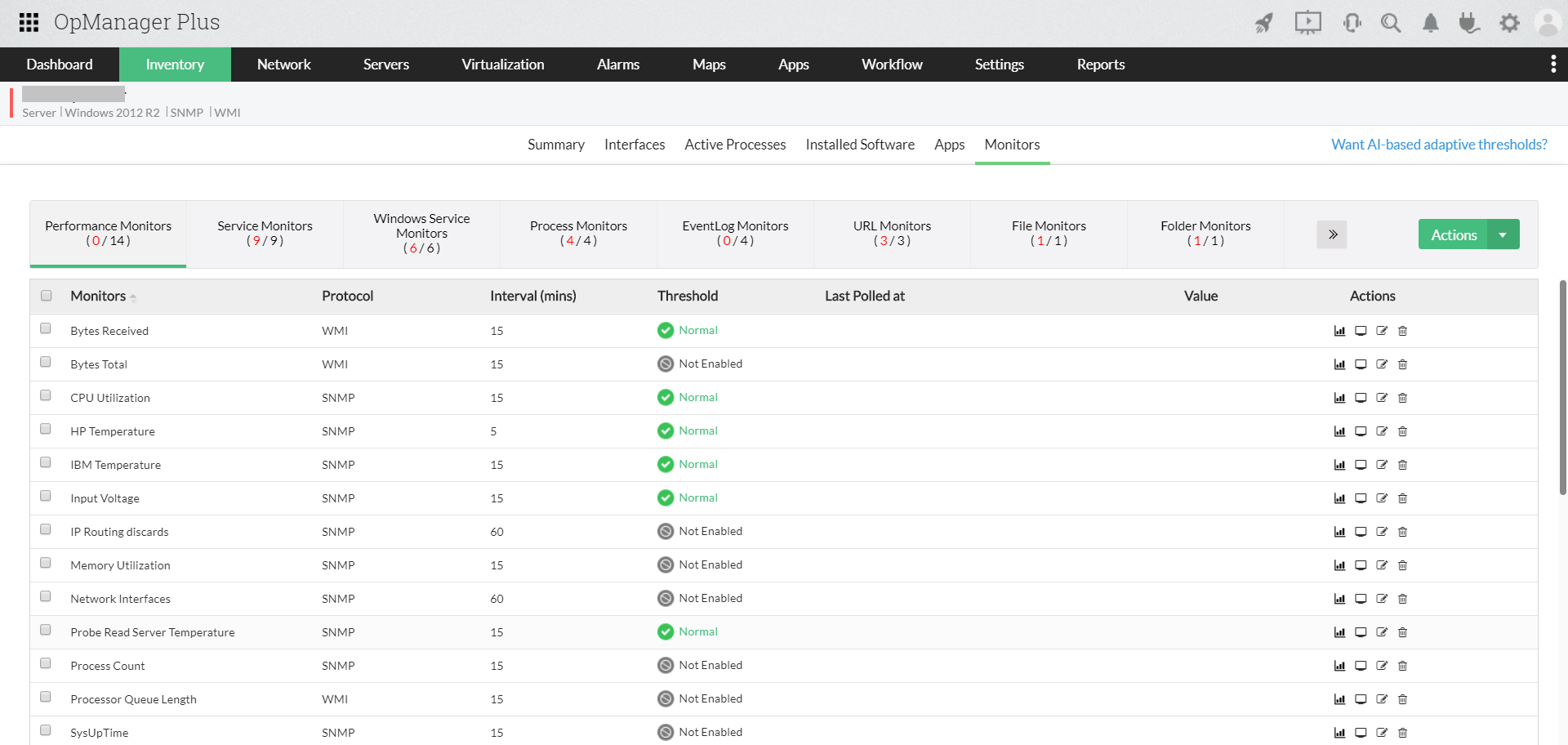
Bandwidth analysis and traffic shaping:
With OpManager Plus, detailed traffic and bandwidth analysis ensure your business-critical applications never run into bandwidth issues. You can employ advanced security analysis management for both wired and wireless devices, which in turn allows you to create a network traffic policy specific to your organization's needs.
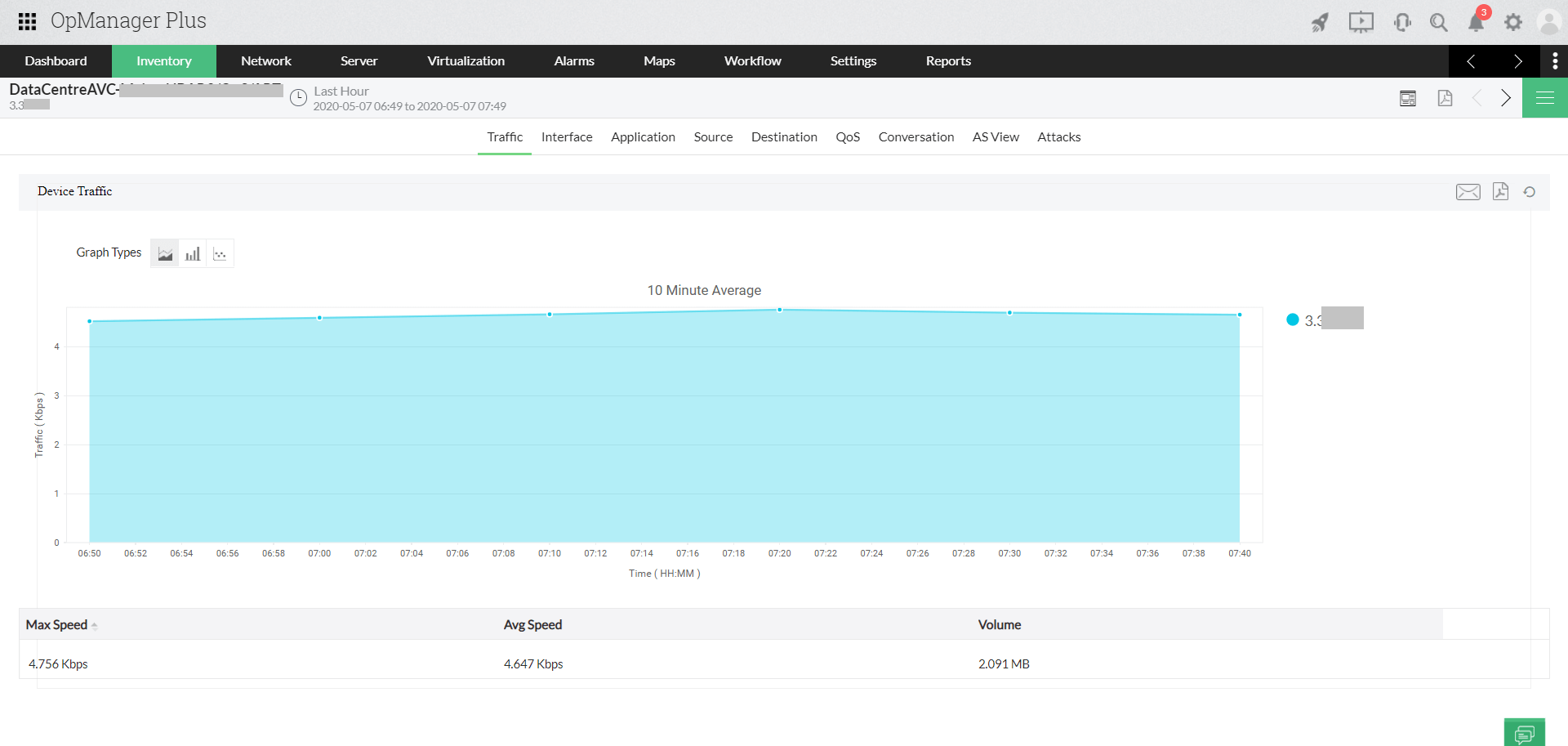
Infrastructure configuration and compliance management:
Device configuration changes, when not monitored, can lead to network disasters. A number of OpManager Plus' features simplify managing a network's configuration. These features include setting rule-based access, configuring backups, the ability to track user-based activity, and restoring devices to their previous working conditions in case of a network outage. These capabilities make network infrastructure monitoring and management easier for the admins.
You can also ensure devices stay up to date with latest compliance policies such as Cisco IOS, SOX, HIPAA, PCI, and custom policies, in addition to firewall policies such as PCI DSS, ISO 27001, NIST, SANS, and NERC-CIP.
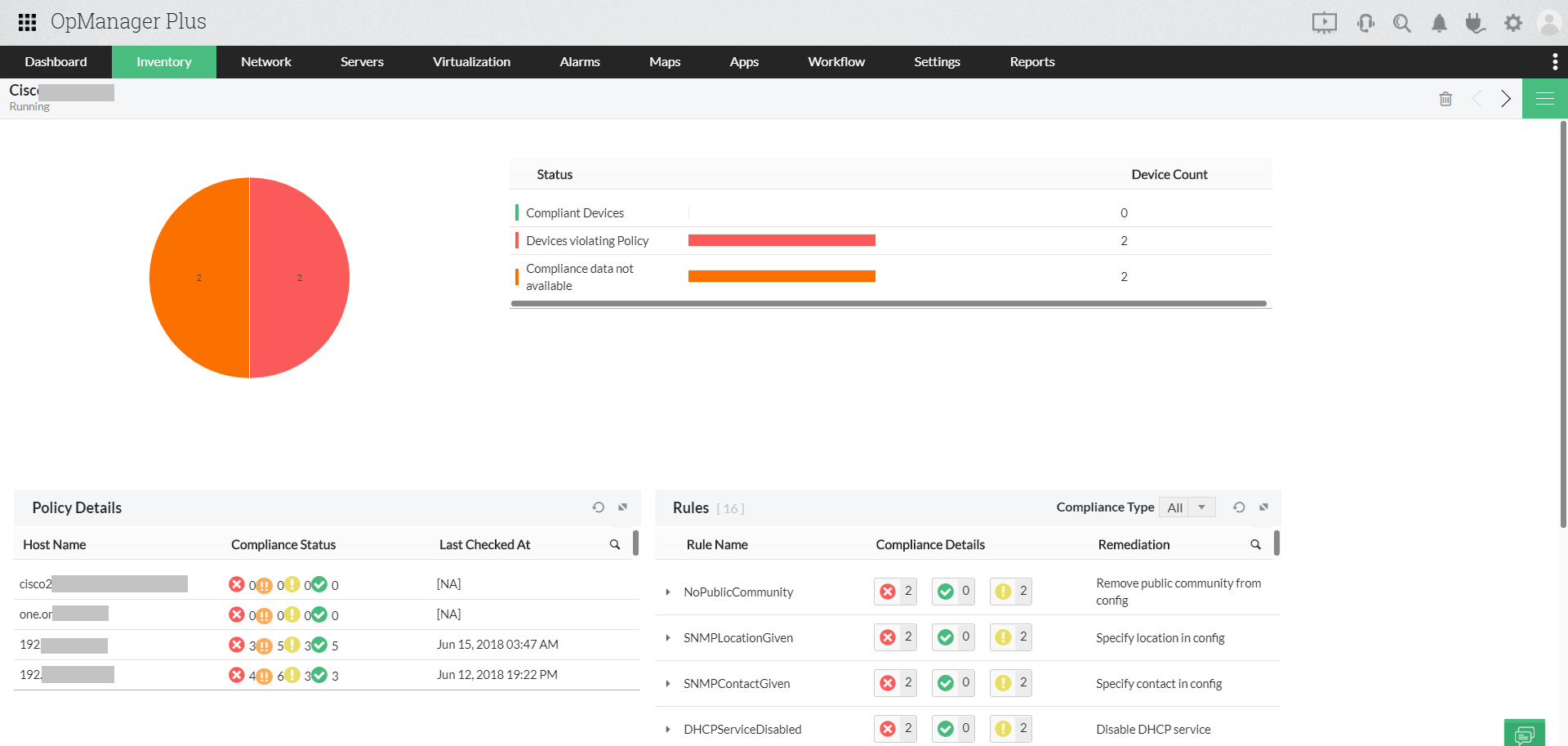
Firewall log analysis and security monitoring:
Firewall logs provide valuable information on how your firewall handles your inbound and outbound internet traffic, but sorting through large amounts of log files is time-consuming. To prevent this, OpManager Plus offers rule-based, agentless log analysis that provides insights into bandwidth and traffic behavior. In-depth analysis of security logs provides a better understanding of security threats and breach attempts, allowing you to plan an effective firewall strategy.
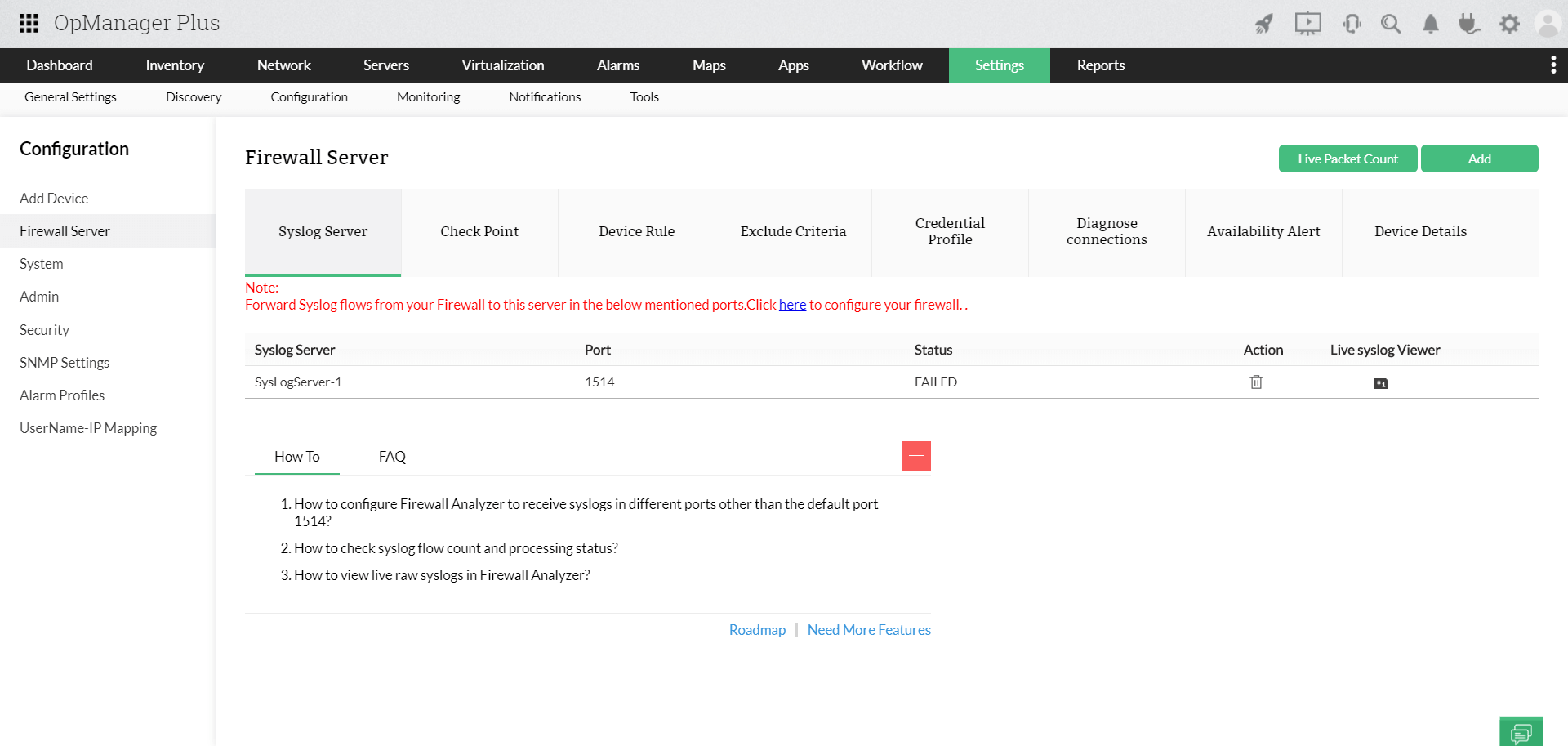
IP address and switch port monitoring
In any organization, planning, tracking, and managing the IP address of infrastructure components is a pivotal requirement. OpManager Plus, a comprehensive ITIM software provides both IP address and switch port monitoring, enabling you to view your IP infrastructure from a central interface. This allows for convenient operations, such as preventing IP duplication, mapping switch ports to their devices, rogue device detection, etc.

The role of an ideal ITIM platform is to produce actionable insights that take into account all of the above factors, and help you get your system's infrastructure back into running condition as soon as possible when you run into trouble.
Fault analysis and workflow management
To facilitate less manual intervention and increased efficiency of fault management operations, OpManager Plus, reliable ITIM tool comes pre-equipped with an advanced, simple-to-use, code-free Workflow builder leveraged to perform automatic fault management operations such as starting, shutting down, and restarting systems; triggering configuration push across multiple systems and cross platforms; initiating process, service, file, and folder management activities; and more.
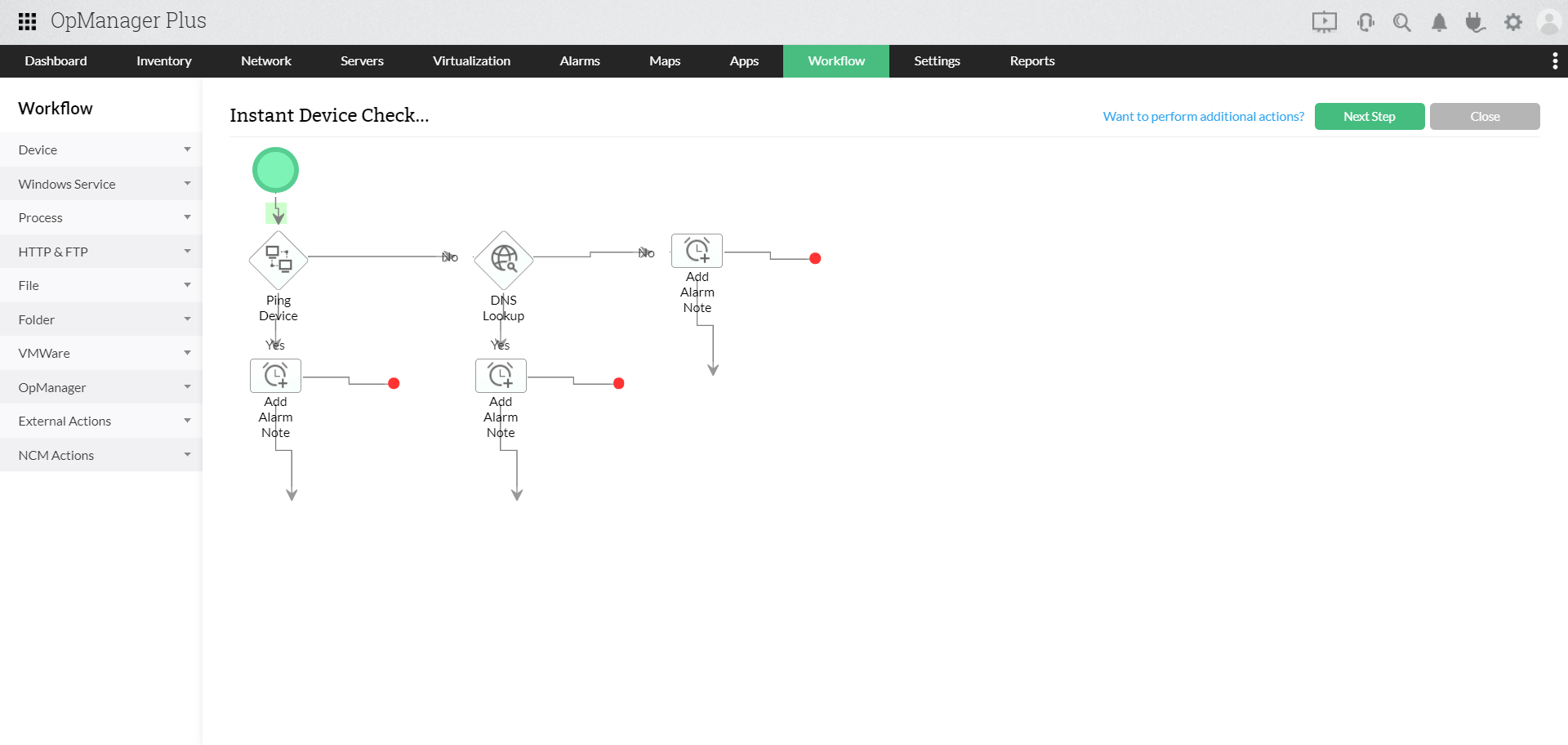
Seamless third-party integration
Integrations, when done proficiently, can help extend the capabilities of your IT infrastructure monitoring tool. Albeit not necessary, integrations like ServiceDesk Plus can help assist in finding faults well in advance, so you'll have enough time to convey it directly to your technician and ensure timely action is taken and your IT infrastructure management (ITIM) services run uninterrupted.
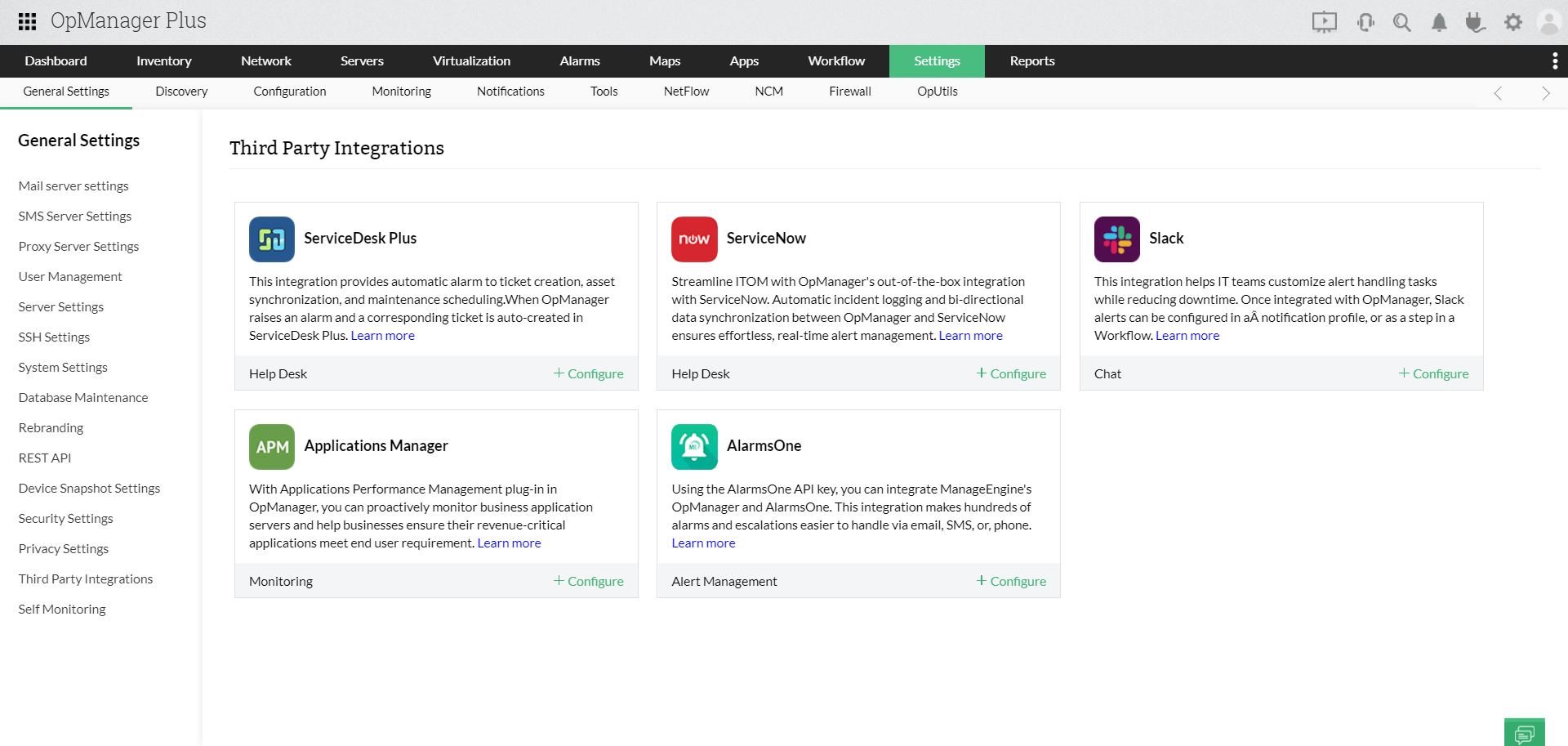
Advantages of OpManager Plus as a Network ITIM tool
OpManager Plus is an advanced ITIM and network operations management solution that boasts exceptional IT infrastructure management (ITIM) components capable of managing your infrastructure proactively with a systematic approach.
- Gain advanced visibility and health statistics across all your infrastructure components from a central command center with the help of customizable dashboards and a network operations center (NOC) view.
- OpManager Plus, a powerful ITIM solution contains a barrage of monitoring and alerting systems, alarm escalation rules, and also process traps and syslogs to ensure none of your infrastructure alerts go missing.
- OpManager comes with built-in data center visualization features that allow you to monitor your data center with real-time, in-depth visual representations using Rack and 3D Floor View.
- Integrate out of the box with third-party tools like ServiceNow, Service Desk Plus, AlarmsNow, and Slack, or utilize REST API to integrate with any third-party tools.
- Optimize performance analysis with over 200 advanced default reports, or create your own custom reports.
OpManager Plus can be the vital cog-in-the-wheel in your pursuit to achieve full stack observability from a single console. With OpManager Plus' observability capabilities you can efficiently manage IT infrastructures of any size thanks to deep observability into physical and virtual infrastructures. Track mismanaged bandwidth consumption between individual devices and establish real-time change monitoring. Automate network configuration changes and control management tasks by centrally applying configuration changes to devices in bulk. OpManager Plus in variety of pricing options from which you can pick the perfect fitment for your organization. Start with a free demo rightaway!


